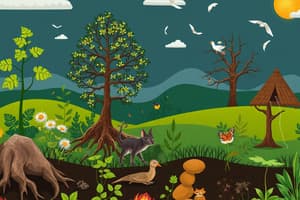Podcast
Questions and Answers
What role do decomposers play in an ecosystem?
What role do decomposers play in an ecosystem?
- They compete with other organisms for living resources.
- They primarily depend on living hosts for survival.
- They extract energy from dead matter and recycle nutrients. (correct)
- They provide energy for photosynthetic organisms.
Which of the following relationships involves one organism benefiting while the other is harmed?
Which of the following relationships involves one organism benefiting while the other is harmed?
- Protocooperation
- Commensalism
- Parasitism (correct)
- Mutualism
In a mutualistic relationship, what is true about the benefits received by the organisms involved?
In a mutualistic relationship, what is true about the benefits received by the organisms involved?
- One organism benefits while the other remains unaffected.
- Both organisms benefit, and the relationship is obligatory. (correct)
- The benefits are optional for both organisms.
- One organism is always harmed in the relationship.
According to the first law of thermodynamics, energy can:
According to the first law of thermodynamics, energy can:
What is the primary outcome of competition between two organisms?
What is the primary outcome of competition between two organisms?
What is the correct order of ecological levels of organization from smallest to largest?
What is the correct order of ecological levels of organization from smallest to largest?
Which of the following accurately describes abiotic factors in an ecosystem?
Which of the following accurately describes abiotic factors in an ecosystem?
What characterizes a biosphere?
What characterizes a biosphere?
Which of the following statements best distinguishes interdependence from interconnectedness?
Which of the following statements best distinguishes interdependence from interconnectedness?
Which of the following is an example of a biotic factor?
Which of the following is an example of a biotic factor?
What impact does light energy from the sun have on ecosystems?
What impact does light energy from the sun have on ecosystems?
How are plants categorized based on their water requirements?
How are plants categorized based on their water requirements?
Which of the following best describes the term 'energy flow' in an ecosystem?
Which of the following best describes the term 'energy flow' in an ecosystem?
What role does wind or air currents play in the environment?
What role does wind or air currents play in the environment?
How does temperature influence organisms on Earth?
How does temperature influence organisms on Earth?
Which factor is affected by soil texture?
Which factor is affected by soil texture?
What defines autotrophs in an ecosystem?
What defines autotrophs in an ecosystem?
Which of the following describes heterotrophs?
Which of the following describes heterotrophs?
How do abiotic factors relate to biotic factors in an ecosystem?
How do abiotic factors relate to biotic factors in an ecosystem?
Which of the following best describes soil pH's role in biological activities?
Which of the following best describes soil pH's role in biological activities?
What factor primarily influences the vegetation zones on Earth?
What factor primarily influences the vegetation zones on Earth?
Flashcards are hidden until you start studying
Study Notes
Ecology Concepts
- Interconnectedness vs. Interdependence: Interconnectedness refers to the complex relationships and connections within ecosystems, while interdependence highlights reliance among species and environments.
- Ecological Levels of Organization: Ranges from individual organisms to the biosphere, outlining the structure of ecological systems.
Ecological Levels of Organization
- Biosphere: The global sum of all ecosystems; also known as the ecosphere.
- Ecosystem: Combination of biotic (living) communities and abiotic (non-living) environmental factors.
- Community: Different populations of various species coexisting in a specific area.
- Population: Group of organisms from the same species inhabiting a defined area.
- Organism: Any individual living entity, including plants and animals.
Components of the Environment
- Abiotic Factors: Non-living components that influence ecosystems such as light, water, and temperature.
- Biotic Factors: Living components including autotrophs (producers), heterotrophs (consumers), and decomposers.
Abiotic Factors
- Light Energy: Essential for photosynthesis; influences nocturnal and diurnal behaviors due to day length variations caused by Earth's rotation.
- Water: Segregates organisms into terrestrial and aquatic classes; plants categorized as hydrophytes, mesophytes, and xerophytes based on water needs.
- Atmospheric Gases: Key gases include oxygen (for respiration), carbon dioxide (for photosynthesis), and nitrogen (for protein synthesis).
- Wind/Air Currents: Aids in transporting water vapor, thus influencing precipitation and aiding plant pollination and seed dispersal.
- Temperature: Affects species distribution; linked to Earth's seasonal rotations, influencing survival behaviors like dormancy and migration.
- Soil Factors: Composition (sand, silt, loam, clay) determines vegetation, while soil temperature and water influences decomposition and mineral availability.
- Physiographic Factors: Geography impacts vegetation types based on altitude, sun exposure, and climate influences.
Biotic Factors
- Autotrophs: Organisms that produce their own food using sunlight or inorganic materials; known as producers.
- Heterotrophs: Organisms that obtain food by consuming others; categorized into herbivores, carnivores, and omnivores.
- Decomposers: Organisms like bacteria and fungi that break down dead matter, returning nutrients to the ecosystem.
Nutritional Relationships
- Competition: Involves two organisms competing for the same resources.
- Parasitism: One organism benefits (parasite) while the other (host) is harmed.
- Predation: One organism (predator) feeds on another (prey).
- Commensalism: One organism benefits, the other is unaffected.
- Protocooperation: Both organisms benefit but the relationship isn't essential.
- Mutualism: Both organisms benefit significantly and rely on each other.
Energy Flow in Ecosystems
- First Law of Thermodynamics: Energy cannot be created or destroyed but can only change forms; fundamental in understanding energy transfer within ecosystems.
Studying That Suits You
Use AI to generate personalized quizzes and flashcards to suit your learning preferences.




